Feedback Loops on Arctic Sea-ice Loss
There is no doubt that anthropogenic carbon emission is an important driver of the diminishing Arctic sea ice extent. Moreover, a rather consensual view suggests that the very nature of the Arctic system (i.e. channels for various feedback loops) leads to the amplification of such external shocks, making the Arctic warm faster than anywhere else on Earth.
Introduction
Understanding Arctic sea-ice loss is a pressing issue faced by the climate community. 2019 IPCC Special Report on Polar Regions highlights that: “Arctic sea ice extent continues to decline in all months of the year (very high confidence); the strongest reductions in September (very likely –12.8 ± 2.3% per decade; 1979–2018) are unprecedented in at least 1000 years (medium confidence).” Particularly, in the latest CMIP6 climate models, a vast majority of simulations show that the Arctic will become sea-ice free in September for the first time before the year 2050 in most emission scenarios (SIMIP Community, 2020). See Figure 1 for the graphic projection of Arctic sea-ice for CMIP6 models and Figure 2 for the spatial illustration of sea-ice concentration decrease in the Arctic.
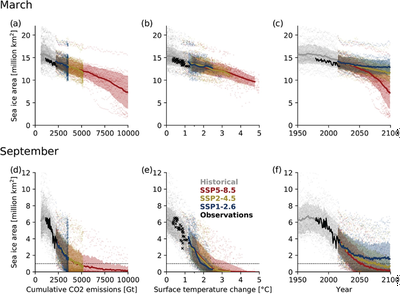
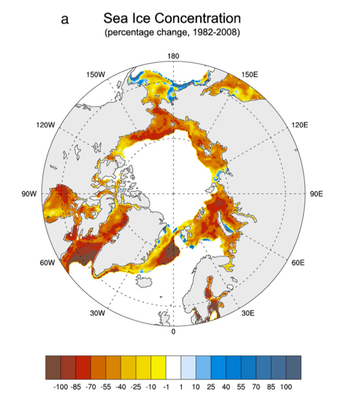
There is no doubt that anthropogenic carbon emission is an important driver of the diminishing sea ice extent. Moreover, a rather consensual view suggests that the very nature of the Arctic system (i.e. channels for various feedback loops) leads to the amplification of such external shocks, making the Arctic warm faster than anywhere else on Earth. There are a lot of such feedback loops documented in existing literature, and I would like to take an extensive survey of them to see how they contribute to the sea ice loss respectively for my class project. See Figure 3 for a schematic overview of some important feedbacks.
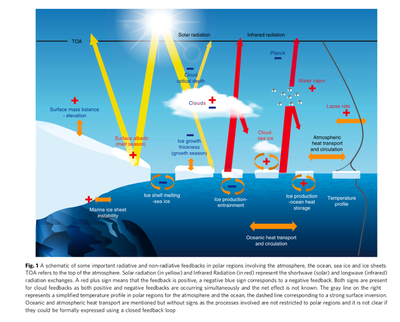
According to 2019 IPCC Special Report on Polar Regions: “Mechanisms for Arctic amplification are still debated, but include: reduced summer albedo due to sea ice and snow cover loss, the increase of total water vapor content in the Arctic atmosphere, changes in total cloudiness in summer, additional heat generated by newly formed sea ice across more extensive open water areas in the autumn, northward transport of heat and moisture and the lower rate of heat loss to space from the Arctic relative to the subtropics (Serreze and Barry, 2011; Pithan and Mauritsen, 2014; Goosse et al., 2018; Stuecker et al., 2018)” In my following sections, I plan to start from reviewing the most clear feedback loops in the Arctic, and then move to discussing those feedback loops that we are still debating about their impact.
Albedo feedback
The albedo feedback is often considered the primary positive feedback which accelerates the loss of sea ice. The Albedo measures the surface’s capacity to reflect solar energy back to the space. Since snow and ice are very reflective, they have high Albedo and therefore reflects a significant portion of solar energy in the polar regions. But as we see the global temperature rises, sea-ice sheets melt to water and now the surface is covered by sea water or land, which are less reflective (i.e. lower Albedo) and will absorb more heat from solar radiation. As a result, more heat leads to more warming, accelerates the loss of sea-ice and decreases Albedo in the polar regions, thus amplifying the initial warming. See Figure 4 for an illustration of the difference between the amount of sunlight Greenland reflected in the summer of 2011 versus the average percent it reflected between 2000 to 2006. Interestingly, Lorius, et al (1990) provides evidence that in the geologically past, the Ice-Albedo feedback plays a significant role in the advance and retreats of the Pleistocene ice sheets.
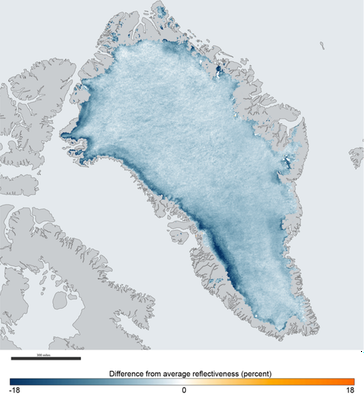
Cloud cover feedback
There are still debates about cloud’s net effect (cooling or warming) in contributing to the global warming since there is significant seasonality and large spatial variation in clouds conditions around the globe. As captured by the IPCC AR4 model discussed in Vavrus, et al (2009), clouds have a net cooling effect at low latitudes but a net warming effect at the Arctic region. Indeed, Goosse, et al (2018) claimed that “cloud feedbacks are the most uncertain radiative feedback as the cloud radiative effect depends on several factors that can be modified by the initial response to the perturbation.” The authors then showed that there are two main cloud feedback loops-one positive, one negative-that could impact the loss of Arctic sea-ice.
The positive feedback is called the “cloud sea-ice feedback”. The mechanism is the following as discussed in Abbot, et al. (2009): as global temperature rise, sea-ice melts more in the spring. The thinner spring sea-ice leads to higher summer heat accumulation in surface ocean, resulting in increased heat and moisture fluxes from ocean to atmosphere. The increased fluxes form thicker clouds and higher water vapor. This leads to higher downward longwave radiation flux to the surface, warming the surface and leading to even more sea-ice melt. This process is supported by the observational study in Huang, et al (2019), which shows that increased Arctic cloud cover in the spring is linked with sea ice decline through satellite data diagnosis and numerical modelling.
The negative feedback is called the “cloud optical depth feedback”. As proposed in Michell and Ingram (1989), this feedback can occur at both high- and mid- latitudes regions, and the mechanism goes like the following: As temperature rises, the total amount of water particles held in clouds increases. Since cloud water particles are smaller than cloud ice particles, they are more efficient in reflecting solar energy back to space. Since clouds become more efficient in reflecting solar energy, they partially offset the initial temperature rise, creating a negative feedback loop.
Temperature feedback
Although the albedo feedback is often considered as the primary contributor to Arctic amplification, such amplification is also found in models without ice and snow retreat (so no albedo effect). In Pithan and Mauritsen (2014), by analyzing CMIP5 simulations, the authors identified two additional temperature channels that account for the Arctic amplification–more energy is radiated back to space in low latitudes regions, compared to the Arctic. In the literature, they are called the Planck feedback and the lapse-rate feedback, and their combined effects induce more Arctic warming than tropics warming.
The Planck feedback acts as a negative feedback on overall across the globe, but it makes the Arctic warms more than the tropical regions. It is based on the physics law $R=\epsilon \delta T^4$, where $R$ is the longwave radiation emitted by Earth to the space, $\epsilon$ is the surface emissivity, $\delta$ is the Stefan Boltzmann constant and $T$ is the temperature. It is an overall negative feedback because the physics law dictates that when there is more warming (i.e. higher $T$), there is more outgoing radiation (heat loss) emitted by earth (i.e. higher $R$). But this law also suggests that there is more warming in the Arctic than the tropics because Arctic has a lower baseline temperature than the tropics. So, for per unit of warming (i.e. $T$ increases by 1 unit), more radiation (heat loss) will be emitted from the tropics than the Arctic because of the fourth power on T, making the tropics cool more than the Arctic.
While lapse-rate feedback is negative in the tropics, it is often positive in the Arctic. In meteorology, lapse-rate refers to the decrease of temperature with height, and it changes from low latitudes to high latitudes. In low latitudes, there is tighter coupling between surface and upper-tropospheric temperatures. So, when climate becomes warmer, there is greater warming in the upper-troposphere than the surface, making more efficient releasing heat to the space. But in high latitudes, there is more stratification between surface-near atmosphere and upper troposphere. So, when temperature rises, the warming is mostly confined in the surface, making it inefficient releasing heat to the space. Therefore, since low latitudes release heats more efficiently, we observe more warming in the Arctic than in the tropics.
Water vapor feedback
Water vapor is most prevalent greenhouse gas in our atmosphere. Since warmer air can sustain a higher-level humidity than cooler air, a rising temperature will increase the amount of water vapor in the air, lead to more significant greenhouse effect and induce further warming. This is a well-studied positive feedback and has the largest impact in the tropics where temperature is higher and the increase in water vapor is at its maximum. Nevertheless, the water vapor feedback is still relevant (although weaker) in polar regions as shown Taylor, et al (2013) on the decomposition of polar feedback contributions.
Sea-ice feedbacks
There are multiple feedbacks associated with sea-ice such as sea-ice growth-thickness feedback. Generally speaking, Arctic sea-ice is becoming thinner and younger comparing to historical records. Using a combination of satellite data and submarine measurements, Kwok (2018) documents that Arctic ice cover has lost about two-thirds of its thickness since 1958, and today 70 percent of the ice are seasonal ice that forms in the winter and melts in the summer. The seasonal ice has different properties than multiyear ice: they are thinner, younger, saltier and more likely to break up. See Figure 5 for the spatial sea-ice age change.
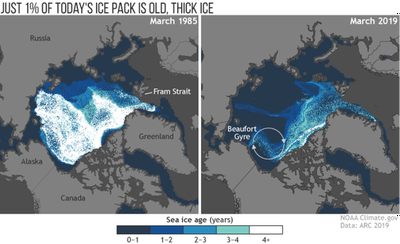
To understand sea-ice growth-thickness feedback, as discussed in Maykut (1986), we first notice the fact that sea-ice growth rate is inverse to sea-ice thickness due to heat conduction. That is, sea-ice grows faster when it is thin and slower if it is thick. Moreover, sea-ice melting rate does not depend on its thickness level. Considering both facts, we see that sea-ice growth-thickness feedback is a negative feedback: As temperature rises and sea-ice melts, sea-ice becomes thinner hence grows at a faster rate while melting rate does not change. Therefore, the higher growth rate can partially offset the initial loss of sea-ice due to warming, creating a negative feedback.
In addition to the thickness channel, sea-ice may influence global warming simply by having more movements around the Arctic, but this overall effect is less certain. As more multi-year ice replaced by seasonal ice, the new thinner ice, in addition to having a faster growth rate, becomes more susceptible to wind and atmospheric conditions. It can be pushed around easily by wind and therefore increases the spatial variation of sea-ice thickness across the Arctic region and intertemporal variation year by year. How will these shifted new ice affect the Arctic? We do not have a definite answer so far and this impact requires further analysis.
Bio-optical feedback
In addition to the physical feedback processes discussed above, there are also biological feedbacks that will affect the future of Arctic sea-ice. One example is the positive bio-optical feedback. As discussed in Lengaigne, et al (2009), increasing temperature and the associated sea-ice retreat will lead to phytoplankton booms in the Arctic ocean. These booms will absorb more the solar heat flux at the ocean surface and therefore warm up the sea water. With warmer sea water, ice concentration is going to decrease and lead to worse albedo, therefore absorbing more heat and inducing more warming.
Permafrost carbon feedback
Another well-aware Arctic biological feedback has to with permafrost thawing. As proposed in Schuur, et al (2015), since temperature becomes warmer, Arctic permafrost will thaw more quickly. As a result, the carbon in the form of frozen organic matter buried in the permafrost will be processed by microbes and released as greenhouse gases (e.g. CH4 and CO2) to the atmosphere, amplifying the initial warming effect. 2019 IPCC Special Report on Polar Regions projects: “By 2100, near-surface permafrost area will decrease by 2–66% for RCP2.6 and 30–99% for RCP8.5. This is projected to release 10s to 100s of billions of tons (Gt C), up to as much as 240 Gt C, of permafrost carbon as carbon dioxide and methane to the atmosphere with the potential to accelerate climate change”.
Concluding remarks
The Arctic ecosystem is intricate and complex, and any perturbation will induce a chain of reactions in different directions impacting the system equilibrium. There are numerous different feedback loops triggered by global warming that amplifies Arctic sea ice loss, and here I just presented a few of them that are widely discussed in the literature. My review by no means is complete and interested readers should refer to Goosse, et al (2018) for more comprehensive treatment.
Furthermore, there are literature trying to quantify the relative importance of each feedback. For example, Taylor, et al (2013) concludes that the albedo feedback and net cloud feedback are the two largest contributors of the amplification of polar warming and sea-ice loss. Pithan and Mauritsen (2014) claims that the temperature feedback dominates the albedo feedback in their simulations. For further research, in addition to understanding the qualitative aspect of each feedback separately, it will be greatly useful if scientists can reach more consensus on how to decompose the relative importance of each feedback quantitively to aid for future policy makings.
(This post is modified from my class paper for GEOL204 Global Climate Change at Penn. Highly recommended class if you are interested in enviromental change topics at Penn!)